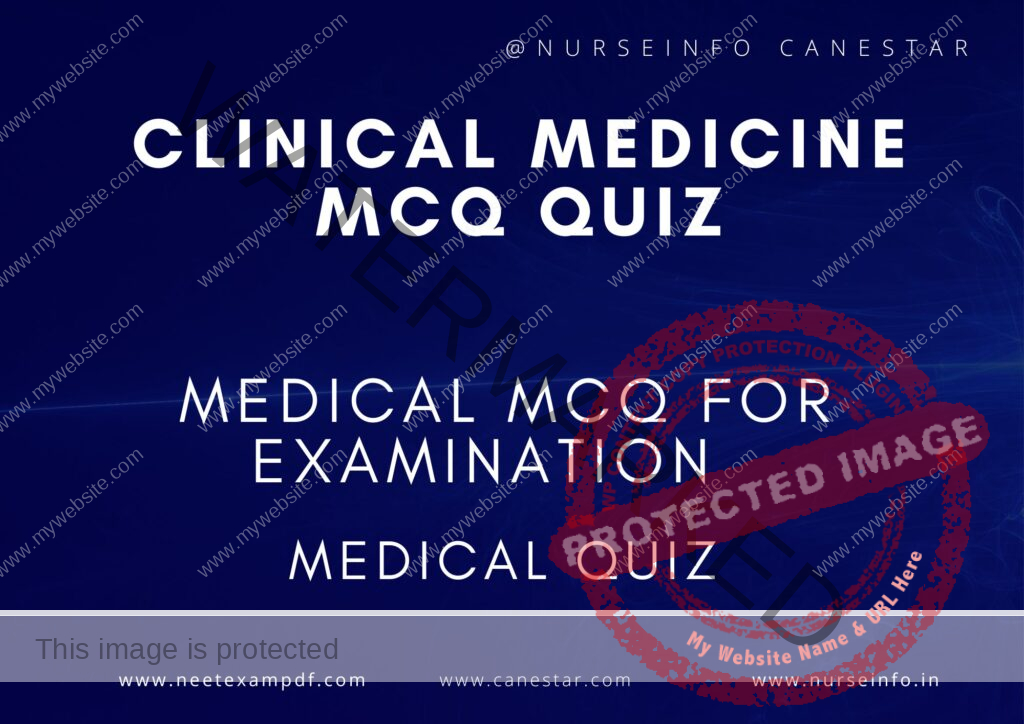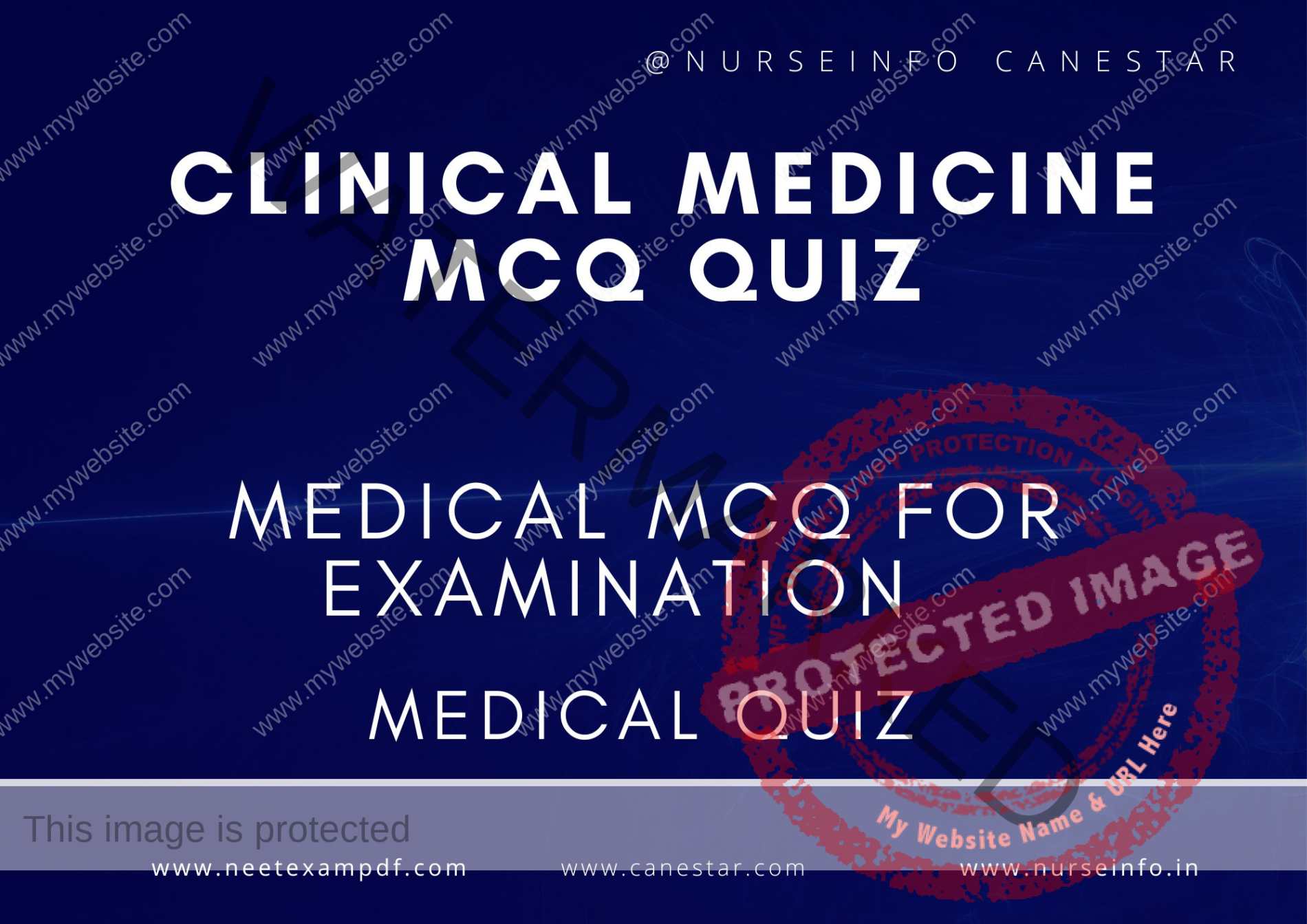MULTIPLE CHOICE QUESTIONS ON CLINICAL MEDICINE PRACTICE QUIZ – MCQS WITH RATIONALE ANSWER – CLINICAL MEDICINE MCQ QUESTIONS WITH RATIONALE
MCQ FOR CLINICAL MEDICINE QUIZ
These mcqs are prepared exclusively for medical professionals for exam preparation. MCQ is helpful to remember the concept on clinical medicine mcq quiz. This multiple choice questions are helpful for preparation for DHA, PROMETRIC, MOH, HAAD, NCLEX, Medical, NEET and Nursing EXAMINATION
1. Which of the following is the most common cause of community-acquired pneumonia?
A) Staphylococcus aureus
B) Streptococcus pneumoniae
C) Mycoplasma pneumoniae
D) Haemophilus influenzae
Answer: B) Streptococcus pneumoniae
Rationale: Streptococcus pneumoniae is the most common cause of community-acquired pneumonia. It accounts for a significant proportion of cases and can cause severe illness.
2. What is the first-line treatment for acute otitis media in children?
A) Azithromycin
B) Amoxicillin
C) Ciprofloxacin
D) Erythromycin
Answer: B) Amoxicillin
Rationale: Amoxicillin is the first-line treatment for acute otitis media in children due to its effectiveness against common pathogens and its safety profile.
3. Which medication is commonly used to treat hyperthyroidism?
A) Levothyroxine
B) Methimazole
C) Propylthiouracil
D) Liothyronine
Answer: B) Methimazole
Rationale: Methimazole is commonly used to treat hyperthyroidism as it inhibits the synthesis of thyroid hormones, making it effective in managing the condition.
4. What is the most common cause of peptic ulcer disease?
A) Nonsteroidal anti-inflammatory drugs (NSAIDs)
B) Helicobacter pylori infection
C) Excessive alcohol consumption
D) Stress
Answer: B) Helicobacter pylori infection
Rationale: Helicobacter pylori infection is the most common cause of peptic ulcer disease. It leads to chronic inflammation of the stomach lining and ulcer formation.
5. Which of the following conditions is characterized by a “butterfly” rash on the face?
A) Dermatomyositis
B) Systemic lupus erythematosus
C) Rosacea
D) Seborrheic dermatitis
Answer: B) Systemic lupus erythematosus
Rationale: Systemic lupus erythematosus is an autoimmune disease that commonly presents with a characteristic “butterfly” rash across the cheeks and nose.
6. What is the primary treatment for an acute myocardial infarction?
A) Aspirin
B) Beta-blockers
C) Thrombolytic therapy
D) Nitroglycerin
Answer: C) Thrombolytic therapy
Rationale: Thrombolytic therapy is the primary treatment for acute myocardial infarction to dissolve the clot and restore blood flow to the affected heart muscle.
7. Which of the following is a hallmark sign of diabetic ketoacidosis (DKA)?
A) Hypoglycemia
B) Hyperkalemia
C) Ketonuria
D) Metabolic alkalosis
Answer: C) Ketonuria
Rationale: Ketonuria, the presence of ketones in the urine, is a hallmark sign of diabetic ketoacidosis, indicating the breakdown of fats for energy due to insufficient insulin.
8. Which electrolyte imbalance is commonly associated with chronic kidney disease?
A) Hypercalcemia
B) Hypokalemia
C) Hyperphosphatemia
D) Hyponatremia
Answer: C) Hyperphosphatemia
Rationale: Hyperphosphatemia is commonly associated with chronic kidney disease due to the kidneys’ inability to excrete phosphate properly.
9. What is the most common cause of chronic cough in non-smokers?
A) Gastroesophageal reflux disease (GERD)
B) Asthma
C) Chronic bronchitis
D) Postnasal drip syndrome
Answer: D) Postnasal drip syndrome
Rationale: Postnasal drip syndrome is the most common cause of chronic cough in non-smokers, often resulting from sinusitis or allergies.
10. Which of the following is a risk factor for deep vein thrombosis (DVT)?
A) Hypertension
B) Hyperlipidemia
C) Immobility
D) Hyperthyroidism
Answer: C) Immobility
Rationale: Immobility is a significant risk factor for deep vein thrombosis as it leads to stasis of blood flow in the veins, increasing the likelihood of clot formation.
11. What is the recommended initial treatment for a patient presenting with acute asthma exacerbation?
A) Oral corticosteroids
B) Inhaled corticosteroids
C) Short-acting beta-agonists
D) Long-acting beta-agonists
Answer: C) Short-acting beta-agonists
Rationale: Short-acting beta-agonists, such as albuterol, are the recommended initial treatment for acute asthma exacerbation to quickly relieve bronchoconstriction.
12. Which of the following is a common symptom of hyperparathyroidism?
A) Fatigue
B) Hypocalcemia
C) Weight gain
D) Hyperkalemia
Answer: A) Fatigue
Rationale: Fatigue is a common symptom of hyperparathyroidism due to the elevated calcium levels affecting muscle function and energy levels.
13. Which condition is characterized by “bulls-eye” lesions on the skin?
A) Psoriasis
B) Erythema multiforme
C) Vitiligo
D) Eczema
Answer: B) Erythema multiforme
Rationale: Erythema multiforme is characterized by “bulls-eye” lesions on the skin, typically resulting from an infection or medication reaction.
14. What is the primary treatment for acute gout attack?
A) Colchicine
B) Allopurinol
C) Probenecid
D) Febuxostat
Answer: A) Colchicine
Rationale: Colchicine is the primary treatment for an acute gout attack due to its anti-inflammatory properties and ability to reduce uric acid crystal-induced pain.
15. Which of the following is the most common cause of hypothyroidism in the United States?
A) Iodine deficiency
B) Hashimoto’s thyroiditis
C) Thyroidectomy
D) Radiation therapy
Answer: B) Hashimoto’s thyroiditis
Rationale: Hashimoto’s thyroiditis is the most common cause of hypothyroidism in the United States. It is an autoimmune condition that leads to the destruction of thyroid tissue.
16. What is the most common initial symptom of multiple sclerosis?
A) Severe headache
B) Visual disturbances
C) Muscle weakness
D) Memory loss
Answer: B) Visual disturbances
Rationale: Visual disturbances, such as optic neuritis, are often the most common initial symptom of multiple sclerosis due to demyelination affecting the optic nerve.
17. Which medication is considered the first-line treatment for hypertension?
A) ACE inhibitors
B) Beta-blockers
C) Calcium channel blockers
D) Thiazide diuretics
Answer: D) Thiazide diuretics
Rationale: Thiazide diuretics are considered the first-line treatment for hypertension due to their effectiveness in lowering blood pressure and their favorable side effect profile.
18. What is the most common type of leukemia in adults?
A) Acute lymphoblastic leukemia
B) Chronic lymphocytic leukemia
C) Acute myeloid leukemia
D) Chronic myeloid leukemia
Answer: B) Chronic lymphocytic leukemia
Rationale: Chronic lymphocytic leukemia is the most common type of leukemia in adults, characterized by the accumulation of small, mature lymphocytes in the blood and bone marrow.
19. Which of the following is a common cause of secondary hypertension?
A) Hyperaldosteronism
B) Hypothyroidism
C) Diabetes mellitus
D) Obesity
Answer: A) Hyperaldosteronism
Rationale: Hyperaldosteronism, or excessive production of aldosterone, is a common cause of secondary hypertension due to its role in increasing sodium and water retention.
20. What is the primary treatment for bacterial meningitis?
A) Antiviral medications
B) Antifungal medications
C) Antibiotics
D) Corticosteroids
Answer: C) Antibiotics
Rationale: Antibiotics are the primary treatment for bacterial meningitis to target and eliminate the causative bacterial pathogens and reduce inflammation.


